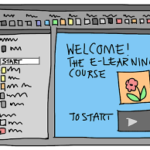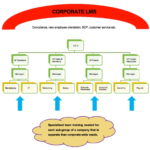by Brian Clark | learning management systems, LMS
Despite the advances in LMS technology and the enormous range of features being added to learning management systems, some organisations still find there are gaps in meeting their learning strategy objectives.
 An organisation facing this reality will often search for a new LMS to meet their needs. This process may be costly in time and financial resources. These are a few ideas that warrant consideration before taking the plunge.
An organisation facing this reality will often search for a new LMS to meet their needs. This process may be costly in time and financial resources. These are a few ideas that warrant consideration before taking the plunge.
- Make sure you have your current LMS configured correctly. Have you changed your configuration to meet new requirements?
- Have you kept pace with updates from your vendor?
- If reporting is not delivering what you need, have you considered integrating with a third party reporting tool?
If you are looking to build a continuous learning framework, the LMS is a great platform to contribute to the framework, but it may need to be supplemented with other tools and processes. You may want to consider these options as well before ditching your current LMS.
- Consider offering micro-learning in your LMS. Make the learning fun and always available by not being linked to sessions and enrolment processes.
- Try using social media to foster greater collaboration and teamwork. The social features in learning management systems vary widely. Social platforms offer a number of ways to engage your people without cost and with a good chance of widespread adoption. YouTube is an incredible resource that is under-utilised for learning across an extended enterprise.
- Offer classroom and online follow-up to your learning programs. We have achieved great results using collaborative communities of practice and expert areas to foster ongoing learning and retention.
- Personalise your learning to individuals and teams. Most learning management systems have the ability to do this to varying degrees. Change the learning programs regularly to keep people interested and engaged.
You can achieve great things as a learning professional using technology and other tools to supplement your LMS. Do not consider the LMS to be the only tool you have to achieve your learning objectives.
by Brian Clark | Business Process, learning management systems, LMS
Specific autonomous training that harmonises with corporate training objectives.
Has there ever been an example when one size truly fits all? A label that’s been stamped on everything from hats and clothing to table cloths and diapers, this type of statement couldn’t be farther from the truth.
These days it’s all about customisation and this is critical into the world of effective training. Studies show that learners may retain information very differently and this has been one of the key drivers in the widespread rapid adoption of blended learning.
This concept also holds true from a trainer’s perspective — one size does NOT fit all when it comes to team training. It is imperative that business units across an organization are equipped with the right tools to meet their specific goals and objectives. And, this often comes with unique training needs that do not always fall under the same organizational LMS umbrella.

Training should be tailored to team needs.
No two teams are alike, nor their training needs.
Every organisation has some type of hierarchy or chain of command that functions along the idea that all the individual units work together for the good of the whole. However, would it be safe to assume that sales and marketing will have very different training needs than manufacturing, safety and HR? Or, IT versus customer service?
While there will always be some cross-over in training needs, there are also a significant number of situations where specific teams need a tailored solution. Common problems teams face include:
- A lack of administrative access or control of the corporate LMS.
- The corporate LMS is too complicated for small team needs.
- The LMS does not offer administrative tools for specific user populations.
- There is an inability to customise learning paths and training for specific team requirements.
If your business is not delivering tailored training and/or performance support to specific teams and groups you may consider the following:
- Review the capabilities of your LMS to determine if you can deliver tailored training and user experiences to specific teams and groups.
- If your LMS has these capabilities but they are not utilised, consult your vendor or support provider to determine the scope of activating this set of capabilities.
- If your LMS does not have this capability you may wish to explore other options. The use of learning management systems across the extended enterprise is now more common and proving an effective business development and competitive differentiator.
If you would like further information on this subject please get in touch with us. We can provide ideas on how to roll out tailored training and show you some e-learning modules designed for these types of scenarios. You may also wish to have a look at an LMS configured for an extended enterprise deployment.
by Brian Clark | learning management systems, LMS, on-boarding, Productivity, succession planning, talent retention
 A step by step guide to choosing the best LMS for your needs
A step by step guide to choosing the best LMS for your needs
How many times have you walked into a store with something specific in mind only to get home and realize that you blew your budget and now are the proud owner of 10 items that you didnt need? Over the years, various LMS systems have tried to be all things to all people; the more bells and whistles the better. With all these added features, choosing your LMS can be overwhelming and confusing which can lead to the above example.
According to a survey conducted by The eLearning Guild, nearly one-third of respondents said they were not satisfied with the LMS product they were using. There could be a variety of reasons for this but one thing is for certain, in order for a successful outcome to happen, a company must know what is most important to them and make sure the LMS performs those requirements well.
This short guide will help clarify how to choose the best learning management system software and avoid the exhaustive and costly mistake of selecting an LMS that is poorly matched to your company needs.
The Wrong LMS Wastes Time and Money
The investment of time and money that organizations make in learning management systems is significant and lets face it, nobody likes to lose time or money.
With over 600+ LMSs on the market, it can be quite daunting to choose the right LMS let alone face the consequences that can set you back months or even years in missed learning opportunities.
Having a well thought out plan ahead of time when considering an LMS is a sure way to avoid buyers remorse. It also is a great way to position yourself for optimal success when choosing a learning management system software.
Choosing the Right LMS
In 2004, American psychologist Barry Schwartz published a book called The Paradox of Choice Why More is Less. It argued that by eliminating the amount of consumer choices will greatly reduce anxiety for shoppers. The following guidelines will set a path for success by eliminating the LMS playing field from 600 to 1. The LMS that best fits your needs and goals.
Preparation
One of the most important parts of the entire LMS selection process is in preparation. This is the time to really focus on the details.
- Choosing an LMS is not a one person job. Its important to create a team made up of a variety of departments in your company. These folks will be using the LMS in different ways and their feedback is critical. The features an information technology person deem important may be quite different then the HR perspective, right?
- Do you have a leader? This person needs to drive the team, an LMS champion. They should be well versed in your company s learning needs, has the backing of management and controls the budget. They should also be able to bridge the various needs of the LMS team and come to a consensus.
- Who will be using the LMS? Its important to define your customers and the ways in which theyll be utilizing the LMS. Come up with a variety of scenarios or initiatives with the customers in mind. Map out exactly what needs to be done and what tools are needed to implement the initiative. One example would be onboarding. If you know that in the next year that your company will be hiring a lot more staff and/or expect changes in user information, it will be particularly useful to have real-time integration features with your selected LMS.
- Make a priority list. Your team of decision makers will be a big help in narrowing down the list. Think about what your company goals are as well as some big projects coming up. Tough decisions will need to be made as needs will not be the same across the organization.
Requirements
Once a priority list has been drafted, it should be fairly easy to translate that into requirements. One of the biggest traps when shopping for an LMS is asking for every feature that is available that may or may not be needed. Follow your list of priorities to stay focused and on task. An easy way to do this is with the 80/20 rule take care of 80 percent of your needs then see how successfully you can fulfill the rest of the 20 percent. Make everything not on your list of priorities to nice to have. Visit our partners, – leaders in fashionable footwear!
Vet available Learning Management Systems
At this point, you have slowly narrowed your priority list down to only the most important features along with some nice to haves. Now, the next step is to narrow your choices of LMS providers. Your list of top 10 requirements will rule out non qualifying products. For instance, if you would like an LMS that will leverage your investment in SharePoint, then this would be a good vetting criterion. There are many different pricing ranges for products. Ballpark licensing costs are another good vetting criteria.
Product Evaluation
- Request for information. An RFI contains a list of all your requirements with a few questions per requirement for vendors to answer. Evaluate the vendor responses with a scorecard that allows scorers to rate how well the vendor meets each requirement on a 5-point scale. After scoring the responses to the RFI, you can rule out some of the lower-scoring vendors and continue evaluating the top contenders.
- In use demonstrations. Invite each of the top contenders to visit your organization for a half day to demonstrate their product. A good approach is to give them all the same use case ahead of time so you can compare them equally. Again, you can use a scorecard to evaluate the vendor demonstration and rule out those vendors whose products did not perform well.
- Trial version. As you continue to evaluate the finalists, you may ask for a trial version of the LMS software where you can explore the finalist products. Hands-on exploration will give you a better sense of the user-interface design, features and capabilities of the product.
LMS Selection 
The final step is to select an LMS. Send a Request for Proposal (RFP) to each of your finalists asking for pricing quotes, implementation timeframes and support options. If you followed the above guidelines, you should feel very confident in your choice of learning management system software.
Leverage the Benefits of Your LMS
You should take the opportunity during your LMS implementation project to review your current business workflows and amend them as desired. You want to gain productivity and automation with your LMS and not be messing around with your LMS to get it do the things you need. There are so many benefits you will gain with an LMS, among these are:
- More engaged workforce with self serve learning and development.
- Reduced training costs.
- Track and report easily to manage compliance and regulatory requirements.
- Engage with new hires and offer consistent high quality on-boarding.
- Use the LMS for resource planning, succession planning and skills gap analysis.
In today s business environment, an LMS is the backbone for training and development and continues to gain in popularity. One of the biggest advantages of an LMS is efficiency. In fact, many companies report a 50-70% cost savings just by switching from instructor-based training to eLearning. Your LMS should be able to manage online, instructor led and blended learning delivery to gain efficiencies in all learning modalities.
by Brian Clark | 70:20:10, LMS, sales training
How to boost your company’s sales using effective blended learning.
Your LMS can make a huge impact on the sales performance of your organisation by supporting effective blended learning. It is often overlooked as a key component of sales and marketing technology, and yet a learning management system will contribute to deliver measurable sales growth if used effectively for both internal and external audiences. I am going to cover some ideas on how to use your LMS for your internal audiences that will form a key part of your sales strategy to deliver sustained predictable revenue growth for your business. We are talking here about people with job titles like those below who are responsible for delivering sales results.
• VP of Sales
• Sales Managers
• Sales Executives
 • Sales Representatives
• Sales Representatives
• Internal Sales
• Marketing Managers and their teams
The most basic use of the LMS is to capture and maintain training histories. This should be no different for your sales team. By maintaining sales training histories you will be able to more effectively measure the return on investment of the training you are investing in. If you are a Sales Manager you should be very interested in this data when you are preparing to request money to undertake further training. If you are a Learning and Development Professional, you may include this data in your reporting to highlight areas of improvement and to verify a link between training investment and improved performance on the job.
• Sales training is often instructor led and the learners are then expected to apply their learning to their jobs. In ideal cases, there is follow up and practical coaching to ensure there is learning retention. If you outsource your sales training, consider these ways to use your LMS to get better results:
• Create competency frameworks for your training that can be aligned with different roles and job titles.
• Ask your training provider for resources that can be adde to the LMS for learners to refer to after the training as refreshers.
• Set up discussion forums to enable informal sharing of ideas and best practices among participants.
• Allow your training provider access to your LMS to participate in discussion forums, add new content and respond to questions.
There are some excellent ‘off-the-shelf’ e-learning programs available for sales and marketing training. We offer one comprehensive program that is designed for the 70:20:10 learning framework. Using this model encourages the natural inclination to learn ‘on the job.’ The framework looks like this:
• 70% of learning occurs through challenges and practices on the job.
• 20% of learning derives from social exposure from personal networks, coaching and other collaboration.
• 10% of learning is achieved from structured courses and programs.
For example, you may offer learners short online learning modules delivered from your LMS. These learning modules are supported by written tools or checklists to apply the learning to the job. Each learner is asked to journal their experiences in applying the learning. A manager or coach meets with the learners every week to discuss the learning content and share ideas and experiences in applying the learning. The LMS is used to facilitate online discussion forums and the individual journalling. The short e-learning modules are available 24×7 for refresher sessions.
Here are some ideas to use a blended e-learning approach to sales and marketing training.
• Use short e-learning modules linked to skills or competencies in your LMS.
• Provide strong linkage between the competencies and the performance objectives of the people in the sales and marketing teams.
• Set up collaborative environments in your LMS. The discussion forums, messaging, expert areas, and supporting content will all help to support learning.
• Establish a management process that includes one on one or group meetings to discuss the learning, competencies and the application of these on the job.
• Ensure managers are ‘shadowing’ and providing supportive coaching to learners on-the-job. For external sales teams this can be termed ‘curb-side coaching.’ For internal people it could mean a sales and/or marketing manager working hands on with the team.
• Ensure the learning and development team meet with the relevant managers to gain feedback and insight on how the learning program is going.
• Establish metrics covering areas such as participation rates, learner feedback, course feedback and of course sales performance.
There are other tools that may also be used to provide a fully integrated approach to sales and marketing training. We have clients who have also developed new sales processes, marketing strategies and customer service processes that are supported by both the LMS and the CRM, [customer relationship management software].
If you are interested in exploring highly effective sales training for your business, please get in touch and we can provide you some ideas and let you experience our short e-learning modules and coaching services.
by Brian Clark | e-learning, learning management systems, LMS
We are very fortunate to welcome some great new clients to our community. As we commence these implementation projects we have been engaged in conversations about how best our new clients can develop a communications strategy to ensure a successful ‘go-live.’ I have captured a few of the tips in the following bullet points. You will notice the process is virtually identical to a branding initiative.
- Develop strong awareness and a reputation before the LMS reaches the ‘go-live’ stage.
- Build loyalty in your organisation by establishing a great name for the LMS environment and focusing on the benefits that will flow to all persons in the organisation willing to use the LMS.
- Get to know your audience[s] for the LMS. You may be rolling out to only a pilot group or your entire enterprise. In either case you should research your audience demographic profile to help you understand their expectations and preferences. When you understand your audience you are better able to cater for diversity.
- Adapt and configure the LMS to suit your audiences. You might be able to segment the user population to cater for the diversity of users. Learning and other content can be designed to meet the needs of different audiences and avoid the bland one-size-fits all style that plagues many learning environments.
- If you don’t know then ask your people. Get out and meet with different types of people in different parts of your organisation. You can set up webinars or short face to face meetings to gain a better understanding of your audiences. You will also be doing a great job at establishing awareness and loyalty to the LMS project.
- Keep the messaging consistent in all of your communications. If the system will have only limited accessibility or content then make sure you communicate this. One of the biggest mistakes you can make is sending mixed messages. For example, some people will become very enthusiastic about online learning and other capabilities of the LMS. If the system is only going to be used to store competency profiles, there will be discontent.
- Make sure the user experience is consistent with the expectations of the audience. If there is going to be a staged roll-out of certain features make sure you communicate this up front. First impressions count. Consider using different learning environments for different audiences.
- Use the power of association to foster greater interest in the LMS. For example you may include content from the organisation’s leadership team. Engage thought leaders both inside and outside your organisation to contribute content.
- Use familiar domain names for your LMS. Using familiar domain names ensures the LMS is seen as part of your IT systems architecture and not simply a bit of software ‘we have for the fun of it.’
- Promote using your organisation’s social and collaboration tools and events. In these days of enterprise social platforms and knowledge portals, signs and posters around the workplace are still effective. Keeping a blog about the LMS roll-out is another great way to engage your audience. Use whatever you have and keep it updated and fresh to instil the importance of this project in all your people.
 An organisation facing this reality will often search for a new LMS to meet their needs. This process may be costly in time and financial resources. These are a few ideas that warrant consideration before taking the plunge.
An organisation facing this reality will often search for a new LMS to meet their needs. This process may be costly in time and financial resources. These are a few ideas that warrant consideration before taking the plunge.



